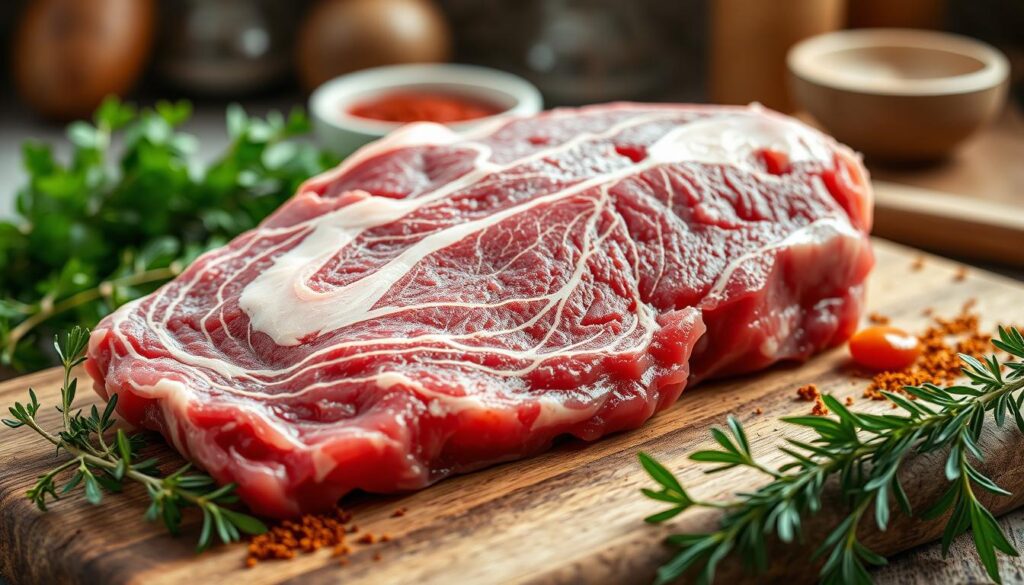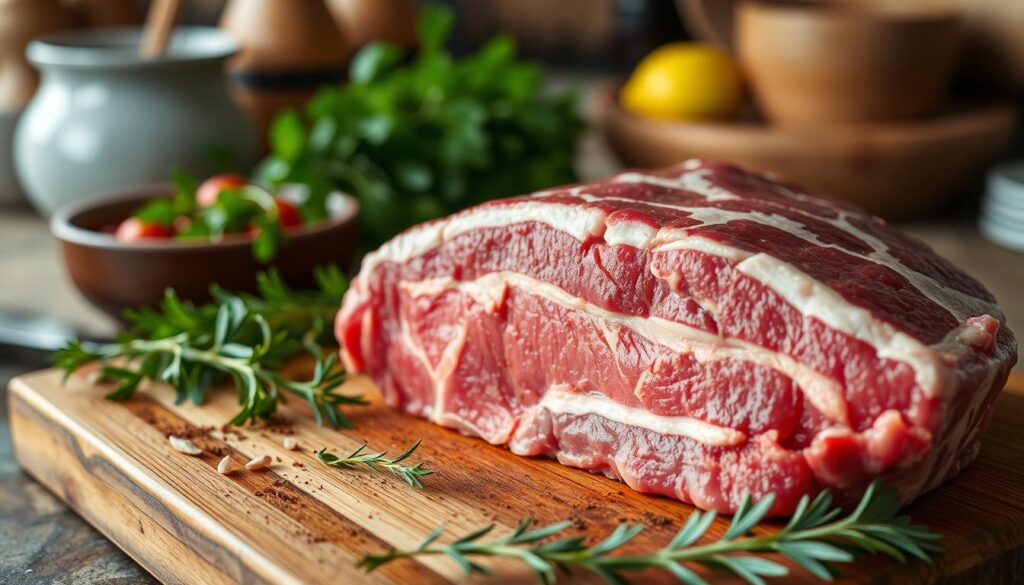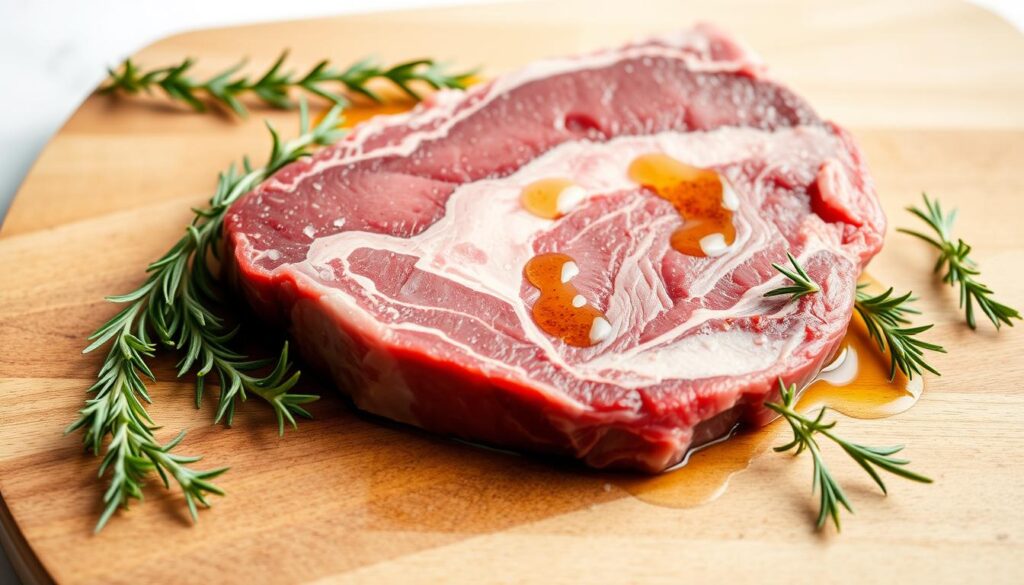
Table of Contents
I love trying new meats, and flap meat is a real winner. It comes from the sirloin and is tender with a strong flavor. It’s great for many dishes, making it a must-try for food lovers.
Flap meat, also known as sirloin flap or bavette, is loved by butchers and chefs. Its marbled texture and beefy taste are perfect for many recipes. It’s great for fajitas and stir-fries. So, why not give it a try?
Understanding the Origins and Location of Flap Meat
Flap meat, also known as bavette, sirloin flap, and bottom sirloin butt, comes from a specific part of the cow. It’s found in the bottom sirloin butt, between the flank and sirloin. This area has hard-working muscles, making the meat robust and flavorful.
Where Flap Meat Comes From in the Cow
Flap meat is a hidden gem, often overlooked but loved by butchers. It’s located in the short loin and flank sections. This makes it a part of the cow’s hardworking muscles, giving beef its unique taste and texture.
Common Names and Terminology
Flap meat is known by several names, including beef lip-on, lip-on, beef navels, and navel meat. These names help identify the different types and locations of this versatile cut. Knowing these terms is key to finding the exact cut you want at the meat counter.
Butcher’s Hidden Secret Revealed
Flap meat was once a secret among butchers, who kept it for themselves. They loved its flavor and versatility. Now, as more people discover flap meat, this secret is being shared with everyone, letting them enjoy its delicious taste.
Characteristics and Flavor Profile of Flap Meat
Flap meat, also known as beef navel ends or beef plates, is a unique and flavorful cut. It has a coarse texture, rich marbling, and a strong beefy flavor. The muscle fibers are long and loosely packed, making it tender when cooked right.
The generous marbling in flap meat lets it soak up marinades and seasonings well. This boosts its natural beefy taste. Compared to other cuts like ribeye, flap meat is leaner with more protein. These traits make it great for many cooking methods and dishes.
“Flap meat is a hidden gem in the beef world, offering an unparalleled balance of texture and flavor.”
Grilled, pan-seared, or slow-cooked, flap meat’s texture and flavor stand out. Its unique qualities make it a top pick for beef lovers. It’s a great addition to any meat lover’s cooking collection.
Flap meat is similar to skirt steak or flank steak in texture and tenderness. But its better marbling makes it more tender and flavorful. Its versatility and value make it a smart choice for a tasty and affordable beef cut.
How Flap Meat Compares to Other Popular Cuts
Beef offers many tasty and versatile cuts. Beef flap meat is a hidden treasure. It’s good to know how it compares to skirt steak and flank steak.
Flap Meat vs. Skirt Steak
Flap meat and skirt steak come from the same part of the cow. However, they vary in taste and fat content. Skirt steak has a strong beef flavor because of its fat. Flap meat is tender and a great choice for those who want a similar taste but a softer texture.
Flap Meat vs. Flank Steak
Flap meat is more tender and marbled than flank steak. Flank steak can be leaner and drier if not cooked right. Flap meat stays moist and tender, even when cooked quickly.
Texture and Flavor Distinctions
Each cut is best cooked quickly over high heat. But they have different textures and tastes. Hanger steak is very tender but has a strong, gamey flavor. Flap meat is tender and has a rich beef taste, making it versatile for many dishes.
| Cut | Texture | Flavor | Availability |
|---|---|---|---|
| Flap Meat | Tender, with good marbling | Robust, beefy flavor | Readily available and affordable |
| Skirt Steak | Coarse, with more connective tissue | Intensely beefy, with a deeper flavor | Limited availability, as there are only 4 skirt steaks per cow |
| Flank Steak | Lean, with a distinct grain | Beefy, but less juicy than skirt steak | Widely available, making it a popular choice |
| Hanger Steak | Exceptionally tender | Robust, almost gamey flavor | Limited availability, as there is only one hanger steak per cow |
Choosing between flap meat, skirt steak, flank steak, and others depends on what you like. Try different cuts to find your favorite for a great meal.

Best Cooking Methods and Preparation Tips
Cooking beef flap meat, also known as sirloin flap, can be a fun challenge. Marinating the meat before cooking is key. It enhances the meat’s tenderness and flavor.
For the best taste, use high-heat cooking like grilling, broiling, or pan-searing. Cook it to medium-rare. This keeps the meat juicy and tender. Let it rest for a few minutes before slicing to keep it moist.
Marinades can include soy sauce, citrus, garlic, and herbs. These add flavor and tenderize the meat. You can also smoke the meat for a special taste.
- Marinate flap meat for 8 to 24 hours for optimal tenderness and flavor.
- Grill flap meat for 2-3 minutes per side to achieve a medium-rare doneness.
- Use a meat thermometer to ensure the desired level of doneness.
- Let the grilled flap meat rest for a few minutes before slicing against the grain.
- Flap meat is versatile and can be used in a variety of dishes, such as fajitas, sandwiches, and stir-fries.
By following these tips, you can make the most of beef flap meat. It becomes a tasty addition to your cooking.

| Cut | Source | Characteristics | Recommended Cooking Method |
|---|---|---|---|
| Beef Flap Meat | Bottom Sirloin | Flavorful, Porous Texture | Grilling, Broiling, Pan-Searing |
| Hanger Steak | Plate/Belly | Intense Flavor, Chewier Texture | Grilling, Broiling, Braising |
| Flank Steak | Belly | Fibrous Texture, Beefy Flavor | Grilling, Broiling, Marinating |
“Flap meat is an underrated cut that deserves more attention. When cooked properly, it can rival the flavor and tenderness of more expensive steaks.”
Conclusion
Flap meat, also known as Bavette d’Aloyau or Bistro steak, is a unique and flavorful cut of beef. It’s from the Sirloin primal group and has a large grain texture. When cooked right, it’s tender and delicious.
Whether you grill, braise, or pan-sear it, marinating well is key. For optimal tenderness, slice it against the grain. This makes flap steak a hidden gem in the culinary world.
It’s affordable and has good marbling, making it versatile in cooking. Pair it with bold marinades, roasted veggies, or your favorite steak sides. You’ll enjoy a satisfying meal with its full-bodied flavor and texture.
The success of your flap meat dish depends on the details. From the marinade to the cooking method, follow the guidelines. You’ll get a truly exceptional steak experience.
So, give flap meat a try. Your taste buds will thank you.
FAQ
What is flap meat, and why is it a flavorful beef cut to try?
Flap meat is a tasty beef cut from the bottom sirloin butt. It’s known for its rich marbling and coarse texture. This makes it perfect for grilling, stir-frying, and making fajitas.
It’s becoming popular because it’s tender and takes marinades well. Plus, it’s cheaper than some cuts like ribeye but has more protein.
Where does flap meat come from in the cow?
Flap meat comes from the bottom sirloin butt in the cow’s hindquarter. It’s also known as bavette, sirloin flap, and bottom sirloin butt. Historically, butchers kept it for themselves because of its great taste and versatility.
What are the characteristics and flavor profile of flap meat?
Flap meat has a coarse texture and rich marbling, giving it a strong beefy flavor. Its long, loosely packed muscle fibers make it tender when cooked right. It’s also lean, with more protein than fat.
Its unique texture and flavor make it great for many dishes. It absorbs marinades well, enhancing its taste.
How does flap meat compare to other popular beef cuts?
Flap meat is different from skirt steak in origin and texture. Skirt steak has a stronger flavor and comes from the plate section. Flap meat is more tender.
Compared to flank steak, flap meat is more marbled and tender. Hanger steak is tender but has a stronger flavor. All these cuts do well with quick cooking over high heat. But flap meat is more forgiving because of its fat content.
What are the best cooking methods and preparation tips for flap meat?
Marinating flap meat before cooking enhances its flavor and tenderness. It’s best grilled, broiled, or pan-seared over high heat. For the best taste, cook it to medium-rare and let it rest before slicing.
It’s great for fajitas, sandwiches, stir-fries, and as a standalone steak. Use marinades with soy sauce, citrus juices, garlic, and herbs. You can also smoke it for a unique flavor.
